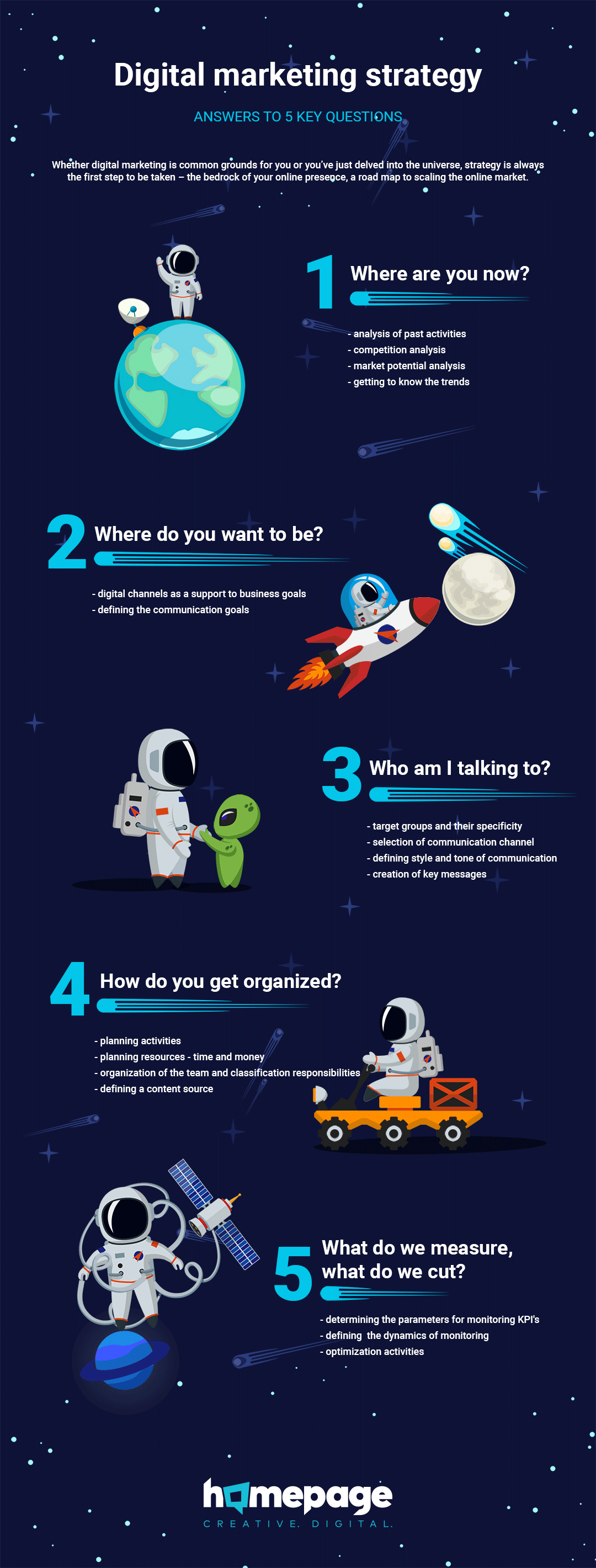Digital marketing strategy
ANSWERS TO 5 KEY QUESTIONS
Whether digital marketing is common grounds for you or you’ve just delved into the universe, strategy is always the first step to be taken – the bedrock of your online presence, a road map to scaling the online market.
Although it typically comes in documents, when it comes to format, a strategy is actually a process that defines all of your online activities: the means, time and place of their online inception, as well as the resources required.
In truth it is a complex process that calls for intense dedication and time investment, however, if you strip it down to its bare essentials and answer the following five questions, you will have yourself a sound structure to build your quality strategy around.
1. Where are you now?
Analyse your historical online approach – what have you done so far and what results has it yielded.
Cast an inspecting eye into the neighbour’s back yard – survey the competition and collect samples of best practices that have been successful for them. Analyse any potential the digital market might currently offer your specific business. Don’t forget to be on the lookout for the trends in digital communications in order to be one step ahead by adopting them into your online presence.
2. Where do you want to be?
In order to achieve your goal, you have to know where you’re headed. A seriously important step in the strategy is setting the goals of your online presence. Experience has shown that this phase is the most demanding of them all. A word of advice: start with the business goal – define what you expect from digital comms channels. This then naturally leads to communication goals that need to be defined in such a way that they are measurable and with a clear timeline.
For example, if one of your goals is to achieve a 20% sales increase from the previous quarter for your online shop, then one of your communication goals metrics could be the monthly number of visits to the online shop.
3. Who am I talking to?
You must have been told this before. If somebody asks you: “Who am I talking to?” that means you are not listening attentively. The topic is not relevant to you, you might not like the tone of voice, or they are just not talking to you at the right time in the right place. They are simply off the mark.
In order to avoid this scenario, define your target groups carefully, establish which digital channels your audience occupies, where its interests lie and how you should reach out to it.
4. How do you get organized?
We know “to whom”, we know “where” – all that is left is “what”, “how” and “when”. To be specific, the next move would be to define the plan of online activities. The plan answers the question what will be done, when and using which channels. It is extremely important to create a synergy between online activities with all other marketing activities. And of course – clearly organize your workforce (duties), timelines and budgets.
5. What do we measure, what do we cut
A most sensible, necessary, even mandatory, yet often neglected, step is specifying the parameters of process monitoring and results measurement. Select a few of the key parameters that you will follow and at least once a month analyse your results, adjust the plan and optimise the budget. What is yielding results you should reinforce and what is failing to deliver needs to be cut out.
You can give it a try yourself, and all can be much clearer if you follow the forthcoming blog post, where we will focus on goals and target groups. If you should require assistance, reach out to us so we can together pave the way of your digital presence.




